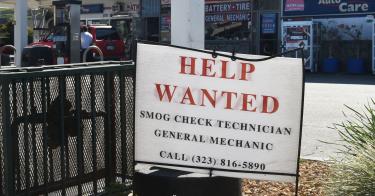If common sense and reports from thousands of employers weren’t enough, a recent National Bureau of Economic Research paper found conclusively that paying people not to work during the COVID-19 pandemic was why many of them remained unemployed.
That shouldn’t come as a surprise to anyone, except that last year, major news reports were saying the opposite was true, before the evidence was in. Leave it to the American media to get something important wrong.
By comparing states that discontinued the overly generous unemployment benefit programs early against those who retained the payouts for the life of the program, the National Bureau of Economic Research researchers showed:
[I]n states that eliminated [the two pandemic-related expanded unemployment benefits programs] in June 2021, the share of 25-to-54-year-old unemployed workers who found employment rose by about 14.4 percentage points in July and August 2021 relative to the share in states that maintained both programs.
This effect is about two-thirds of the baseline monthly flow of unemployed prime-age workers into employment from February through June 2021 in the early-exit states.
Back in August of last year, The New York Times and other members of the media got it wrong. A New York Times front-page article’s headline and lead-in reported:
Cutoff of Jobless Benefits Is Found to Get Few Back to Work
Prematurely ending federal programs had little effect on employment but sharply cut spending, potentially hurting state economies, researchers say.
That would have been counterintuitive, and the National Bureau of Economic Research economists’ research disproves it. Also discrediting it, analysis by University of Chicago economist Casey Mulligan found that the states that did not end unemployment insurance benefits early would have gained 850,000 more jobs in July and August if they had experienced the same recovery paths as the states that did.
Instead, a basic law of economics holds true; namely, that if you pay people more for something, you get more of it, and unemployment is not an exception. Many people collecting enhanced unemployment benefits were being paid more than they had been for holding a job.
A big problem with that is that no one aspires to collect unemployment benefits, because there’s no opportunity for advancing in life by taking a government check with the condition that you stay unemployed.
Another big problem: Unemployed people do not produce anything. They don’t make the economy grow, and America’s astronomical government debt load at 125% of gross domestic product in 2020 is a debt that future generations of Americans will have to pay back or make ever higher interest payments on, subject to the whims of whatever determines the rates.
Already, under current projections and absent a fiscal crisis, the Congressional Budget Office estimates that children today will face a $1.3 trillion annual cost (in today’s dollars) of interest on the debt two decades from now, when they are working.
That’s $8,600 per worker per year just on interest.
Unfortunately, deficit spending—which was 15% of GDP in 2020—is what has funded the prolonged enhanced unemployment benefits.
Moreover, an analysis by The Heritage Foundation found that 40% or more of the entire $873 billion in unemployment insurance benefits may have gone to criminals instead of the unemployed.
The Heritage Foundation has published the Index of Economic Freedom for 27 years. People paid to not enter the workforce are surrendering their labor freedom, which is one of the 12 components of economic freedom in the index.
Similarly, little children being saddled with government debt they will owe for the rest of their lives are having their economic freedom taken away from them to pay today’s adults to not work; as a result, both generations are less economically free.
Legislators should always ask when a policy proposal crosses their desk: “Does this policy proposal increase or decrease the economic freedom of the Americans who voted for me?”
The state governments that ended the gravy train of enhanced unemployment benefits early in their states made the right decision and gained economic freedom and greater opportunity for their constituents.
This piece originally appeared in The Daily Signal




